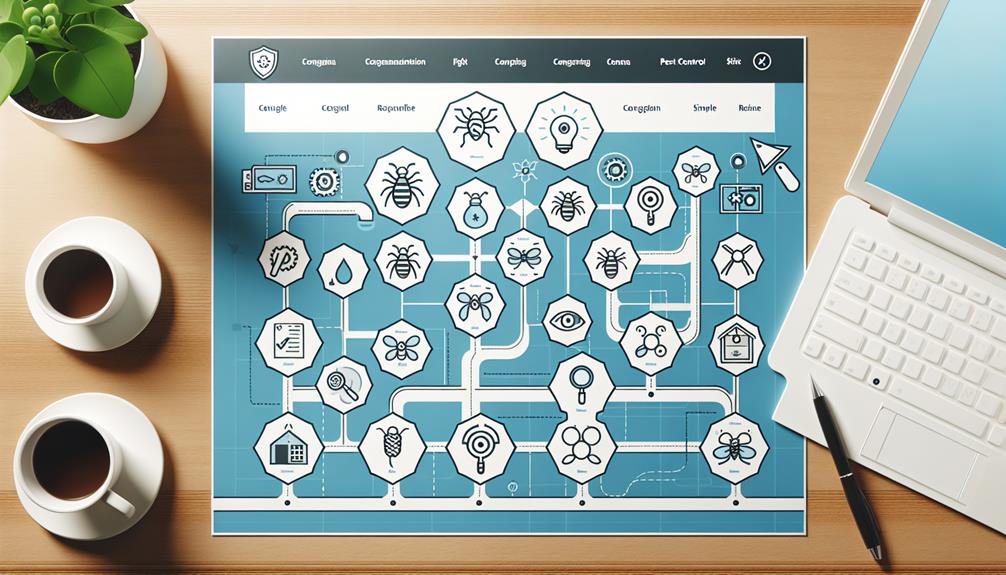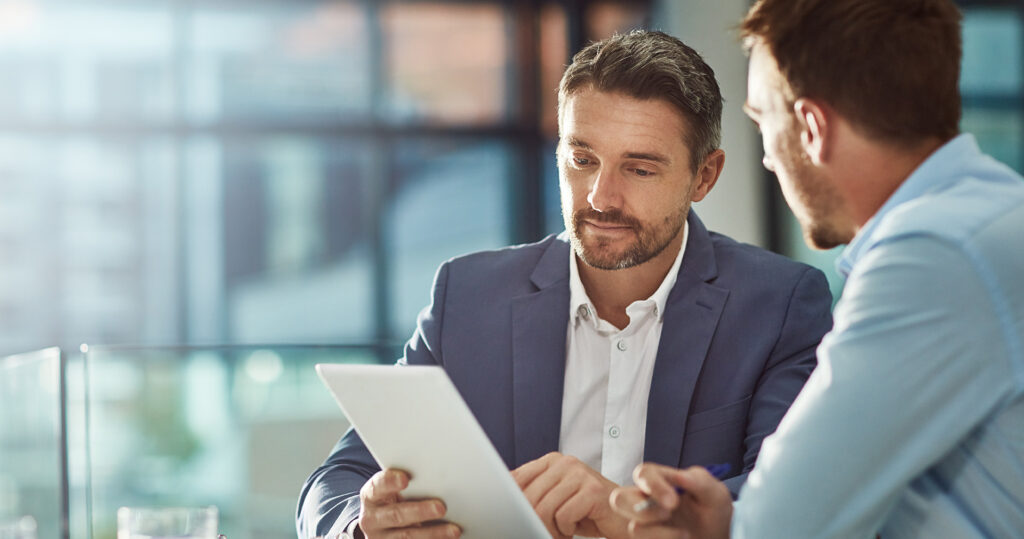Are you tired of your pest control business struggling to stand out in the crowded online marketplace? Well, fear not, because we have the solution for you.
In this discussion, we will explore the 9 best website design strategies that will help your pest control business thrive in the digital age. From clear and intuitive navigation to trust-building elements, these strategies will give your website the edge it needs to attract and engage customers.
So, if you’re ready to take your online presence to the next level and dominate the pest control industry, keep reading to discover the secrets of successful website design.
Table of Contents
ToggleKey Takeaways
- Organize menu items logically and use clear labels for easy navigation.
- Optimize website design for mobile devices and prioritize fast loading speed.
- Utilize engaging visuals and graphics to attract visitors’ attention.
- Create effective calls-to-action and conversion-focused buttons to drive user action.
Clear and Intuitive Navigation

Ensure your pest control website has clear and intuitive navigation to enhance user experience and maximize conversions. A user-friendly interface is crucial for visitors to easily find the information they need and take desired actions on your website. To achieve this, focus on creating an intuitive menu structure that allows users to navigate your site effortlessly.
Start by organizing your menu items logically, grouping related pages together. Use clear and concise labels for each menu item, avoiding jargon or ambiguous terms. This way, users can quickly understand what each section contains and navigate to their desired page without confusion.
Consider implementing drop-down menus to further enhance navigation. By organizing subpages under main menu items, you can provide a hierarchical structure that simplifies site exploration. Make sure the drop-down menus are responsive and easy to use, especially on mobile devices, where a significant portion of your traffic may come from.
In addition to a well-structured menu, incorporate other navigational elements such as breadcrumbs, search bars, and call-to-action buttons. Breadcrumbs help users understand their current location within your site, while search bars allow them to find specific information quickly. Call-to-action buttons guide users towards important actions, such as contacting your pest control services or requesting a quote.
Mobile-Friendly Design
To optimize your pest control website for maximum accessibility, it’s essential to adapt your design to be mobile-friendly. With the increasing number of users accessing the internet through their smartphones and tablets, having a responsive layout is crucial to ensure a seamless browsing experience for your potential customers. Here are four key elements to consider when creating a mobile-friendly design for your pest control website:
- Responsive Layout: A responsive layout automatically adjusts to fit different screen sizes, ensuring that your website looks and functions well on any device. This allows users to easily navigate through your site without needing to zoom in or scroll horizontally.
- User-Friendly Interface: Your mobile-friendly design should prioritize usability by simplifying navigation and minimizing clutter. This means using larger buttons and text, optimizing images for faster loading, and ensuring that important information is easily accessible.
- Quick Load Times: Mobile users have limited patience when it comes to waiting for a website to load. Optimize your site to load quickly by compressing images, minimizing the use of heavy scripts, and utilizing caching techniques.
- Clear Call-to-Action: Make it easy for mobile users to take action by prominently displaying your contact information and call-to-action buttons. This ensures that potential customers can quickly and easily reach out to your pest control business.
Fast Loading Speed

Improve your website’s performance and user experience with fast loading speed. In today’s fast-paced digital world, users expect websites to load quickly and provide instant access to information. A slow-loading website can be frustrating and may lead to visitors abandoning your site and seeking services elsewhere.
To ensure your website loads quickly, it’s essential to focus on two key areas: a user-friendly interface and optimized website architecture.
Firstly, a user-friendly interface plays a crucial role in enhancing loading speed. By keeping the design clean, simple, and intuitive, you can reduce the amount of data that needs to be loaded. Minimize the use of large images, videos, and animations, as they can significantly slow down your website. Opt for compressed file formats and utilize lazy loading techniques to prioritize the content that users see initially, allowing the rest of the page to load in the background.
Secondly, an optimized website architecture is vital for fast loading speed. This involves implementing industry best practices such as minifying CSS and JavaScript files, reducing server response time, and leveraging browser caching. By optimizing your website’s code and ensuring efficient data retrieval, you can dramatically improve loading speed.
Incorporating these strategies won’t only enhance your website’s loading speed but also create a seamless user experience, increasing the likelihood of visitors staying on your site and converting into customers.
Engaging Visuals and Graphics
When it comes to engaging visuals and graphics for your pest control website, eye-catching imagery and graphic design elements are key.
These elements not only grab the attention of your visitors, but they also help to communicate your brand message and create a memorable user experience.
Incorporating visually appealing images, illustrations, icons, and infographics can enhance the overall look and feel of your website, making it more inviting and professional.
Eye-Catching Imagery
Engage your audience with captivating visuals and graphics that bring your pest control website to life. Eye-catching imagery can make a lasting impression on your visitors and help convey the professionalism and reliability of your business. Here are some tips to make your visuals stand out:
- Choose a cohesive color palette: Select colors that reflect your brand identity and evoke a sense of trust, while also considering the psychological impact of different colors on your audience.
- Use high-quality images: Invest in professional photography or use high-resolution stock photos that accurately represent your services and showcase your expertise.
- Incorporate relevant illustrations: Illustrations can add a touch of creativity and personality to your website. Consider using custom illustrations that align with your brand’s style and message.
- Optimize for fast loading: Ensure that your images are properly optimized for web to avoid slow loading times, which can lead to user frustration and increased bounce rates.
Graphic Design Elements
Enhance your pest control website with visually captivating graphic design elements that leave a lasting impression on your visitors. When it comes to engaging visuals and graphics, two key elements to consider are color psychology and typography choices.
Color psychology plays a crucial role in creating the right atmosphere and evoking specific emotions. For a pest control website, it’s advisable to use colors like green, blue, and gray. Green represents nature and freshness, while blue conveys trust and reliability. Gray adds a sense of professionalism and stability. By strategically incorporating these colors into your website’s design, you can establish a sense of credibility and reassurance.
Typography choices also contribute to the overall aesthetics and readability of your website. Opt for clean and modern fonts that are easy to read, such as Arial, Helvetica, or Open Sans. These fonts not only enhance legibility but also create a sense of professionalism and trustworthiness.
Effective Calls-to-Action

When it comes to effective calls-to-action (CTAs) on your pest control website, attention to detail is key.
Engaging CTAs that clearly communicate the desired action, such as ‘Schedule an Inspection’ or ‘Get a Free Quote,’ can significantly increase conversion rates.
Additionally, using conversion-focused buttons with contrasting colors and clear, concise copy can help guide visitors towards taking the next step in their pest control journey.
Engaging CTAs
To captivate your website visitors and prompt them to take action, implement compelling and persuasive calls-to-action that entice them to engage with your pest control business. Here are four strategies to create engaging CTAs:
- Use captivating headlines: Craft attention-grabbing headlines that highlight the benefits of your services and create a sense of urgency. For example, ‘Get Rid of Pests Today and Enjoy a Pest-Free Home!’
- Write persuasive copywriting: Use persuasive language to convince visitors to take the desired action. Clearly communicate the value they’ll receive by engaging with your business. For instance, ‘Say goodbye to pests and hello to a clean and comfortable home with our expert pest control services.’
- Incorporate clear and concise instructions: Ensure your CTAs provide clear instructions on what action you want visitors to take. Use action verbs and simple language to guide them. For example, ‘Call now for a free inspection’ or ‘Click here to schedule an appointment.’
- Create visually appealing CTAs: Use eye-catching design elements such as contrasting colors, bold fonts, and enticing graphics to make your CTAs stand out on the page. This will draw attention and increase the likelihood of engagement.
Conversion-Focused Buttons
After implementing engaging CTAs, the next step in optimizing your pest control website is to focus on creating conversion-focused buttons that drive action and encourage visitors to take the desired steps.
Conversion rate optimization is crucial for any business, including pest control companies, as it directly impacts their online success.
When it comes to button placement, strategic positioning is key. Your conversion-focused buttons should be prominently displayed on your website, preferably above the fold, where they’re easily visible to visitors without scrolling.
Use contrasting colors and compelling text to make these buttons stand out and grab attention.
Additionally, consider the placement of your buttons in relation to the content and context of your website.
Streamlined Contact Information
For a pest control business, it’s crucial to have a streamlined and easily accessible contact information on your website. This ensures that potential customers can easily get in touch with you for inquiries or to schedule appointments.
Here are four key strategies to implement for a user-friendly layout and effective communication:
- Clear and Prominent Placement: Place your contact information prominently on your website, preferably at the top of every page. This ensures that visitors can quickly find your contact details without having to search for them.
- Multiple Contact Methods: Provide multiple ways for customers to contact you, such as phone, email, and a contact form. This caters to different preferences and allows customers to choose the method that’s most convenient for them.
- Click-to-Call Functionality: Incorporate click-to-call functionality on your website, allowing visitors to easily call your business directly from their mobile devices. This streamlines the process and encourages immediate action.
- Response Time: Ensure that you respond promptly to customer inquiries. This demonstrates professionalism and a commitment to customer service, ultimately building trust and increasing the likelihood of conversions.
SEO-Optimized Content

Implementing SEO-optimized content is vital for maximizing online visibility and attracting potential customers to your pest control website. To achieve this, you need to conduct thorough SEO keyword research and optimize your website’s content accordingly.
Start by identifying the most relevant keywords that potential customers are likely to search for when looking for pest control services. These keywords could include terms such as ‘pest control,’ ‘extermination,’ or specific pests like ‘ants’ or ‘termites.’ Use online tools to research the popularity and competitiveness of these keywords to ensure you choose the most effective ones for your business.
Once you have a list of targeted keywords, strategically incorporate them into your website’s content. This includes optimizing your website’s headings, titles, meta descriptions, and image alt tags. However, be cautious not to overstuff your content with keywords, as this can negatively impact your website’s ranking. Instead, focus on providing valuable and informative content that naturally incorporates the keywords.
Regularly updating your website’s content with fresh and relevant information is also crucial for SEO optimization. This could include publishing blog articles on pest control tips, industry news, or customer success stories. Not only does this help with SEO, but it also establishes your business as an industry authority and builds trust with potential customers.
User-Focused Content Organization
To ensure an optimal user experience on your pest control website, it’s essential to organize your content in a user-focused manner that enables easy navigation and access to relevant information. Here are four key strategies to achieve this goal:
- User-friendly interface:
Design your website with a clean and intuitive layout that allows visitors to easily find what they’re looking for. Use clear headings, logical menu structures, and prominent call-to-action buttons to guide users through your content.
- Content hierarchy:
Prioritize your content based on its importance and relevance to your audience. Use headings and subheadings to break up your content into digestible sections and highlight key information. This will help users quickly scan your website and locate the information they need.
- Clear labeling and categorization:
Use descriptive labels for your navigation menu and organize your content into logical categories. This will make it easier for users to understand the purpose of each page and find specific information without getting lost.
- Search functionality:
Implement a search bar on your website to allow users to quickly search for specific keywords or topics. This will save them time and effort by directly taking them to the relevant information they’re looking for.
Trust-Building Elements

Build trust with your website visitors by incorporating trust-building elements that showcase your credibility and expertise in the pest control industry.
One effective way to build trust is by including testimonials from satisfied customers. These testimonials provide social proof and demonstrate that your pest control services are reliable and effective. Make sure to include testimonials that highlight specific results and experiences, as this will resonate with potential customers.
Another trust-building element to consider is the inclusion of credibility indicators. These indicators can take the form of certifications, awards, or affiliations with reputable organizations in the pest control industry. By displaying these indicators prominently on your website, you’re showing visitors that you’re a trusted and recognized authority in your field.
Additionally, consider showcasing any media coverage or press mentions your business has received. This can further enhance your credibility and demonstrate that you’re a reputable and trustworthy pest control provider.





